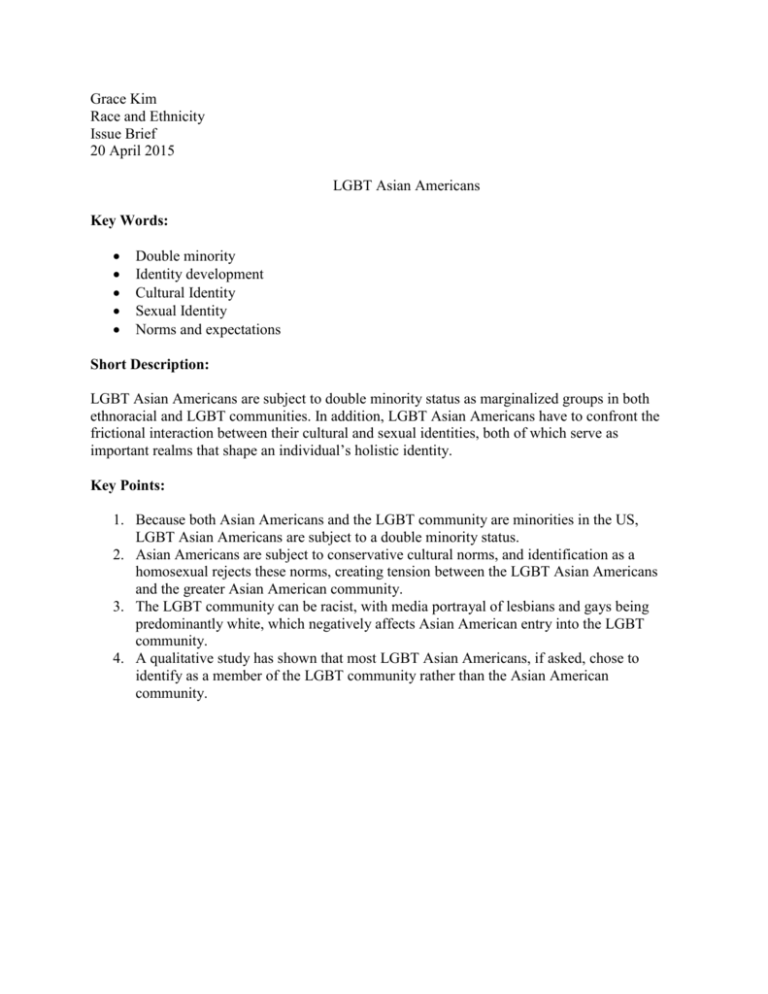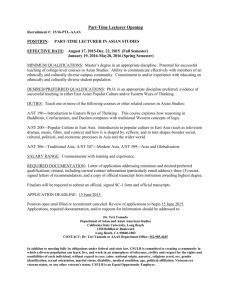
Grace Kim
Race and Ethnicity
Issue Brief
20 April 2015
LGBT Asian Americans
Key Words:
Double minority
Identity development
Cultural Identity
Sexual Identity
Norms and expectations
Short Description:
LGBT Asian Americans are subject to double minority status as marginalized groups in both
ethnoracial and LGBT communities. In addition, LGBT Asian Americans have to confront the
frictional interaction between their cultural and sexual identities, both of which serve as
important realms that shape an individual’s holistic identity.
Key Points:
1. Because both Asian Americans and the LGBT community are minorities in the US,
LGBT Asian Americans are subject to a double minority status.
2. Asian Americans are subject to conservative cultural norms, and identification as a
homosexual rejects these norms, creating tension between the LGBT Asian Americans
and the greater Asian American community.
3. The LGBT community can be racist, with media portrayal of lesbians and gays being
predominantly white, which negatively affects Asian American entry into the LGBT
community.
4. A qualitative study has shown that most LGBT Asian Americans, if asked, chose to
identify as a member of the LGBT community rather than the Asian American
community.
Brief
According to the 2010 US Census,
Asian Americans consist of roughly 5% of the
US population. Additionally, of the 3.4%
Americans who identified as LGBT in a 2012
Gallup poll, 4.3% of Asian Americans
personally identified as lesbian, gay, bisexual,
or transgender. As one of the smallest
source: Gallup
ethnoracial groups, Asian Americans are already a minority in the United States, but with the
additional identity as a member of the LGBT community, they are subject to a double minority
status. Because both of these communities are marginalized, LGBT Asian Americans face issues
with identity development and have to confront the frictional interaction between their cultural
and sexual identities. This friction stems mainly from cultural expectations, and may eventually
pressure these individuals to choose between one identity and the other.
Cultural and sexual orientation embodies two major dimensions around which individuals
figure out who they are and how they root their identities. There are several factors within the
Asian American culture, including gender role expectations and denial of the existence of AsianAmerican lesbians and gays, which negatively react with identification as LGBT. For instance,
the family is valued as the primary social unit within the Asian culture. Within the family
dynamics of the Asian culture, both parents and elders demand a lot of respect and obedience,
and expect conformity to the cultural values, which includes accepting the sharp delineations of
gender roles (Greene). Men are expected to continue the family lineage and name, whereas
women are expected to recognize the importance of being a dutiful daughter, wife and mother.
Identifying as LGBT would essentially reject these gender expectations – a man identifying as
gay would threaten the continuation of the family line, while a woman identifying as lesbian
would reject her role as a wife and mother. They also may be subject to shame, including their
mothers, who are responsible for raising their children to accept appropriate roles within the
culture (Greene). With these familial and gender expectations, LGBT Asian Americans face
cultural obstacles because they are essentially “rejecting” their cultural norms.
Although our current generation is more accepting of
various identities, acknowledgement of LGBT individuals
within the Asian American community may be restricted due to
their outlook on homosexuality. Older generations of Asian
Americans deny the existence of lesbians and gays, and many
perceive homosexuality as a “white, Western phenomenon”
(Chan). An increase in media portrayal of LGBT Asian
Americans may help mediate and accept the presence of Asians
in the LGBT community, but currently, media portrayals
source: gapimny
ignore, devalue and exclude LGBT Asian Americans despite the fact that they’re ready to join
the LGBT community (Florido). Asians are practically non-existent in gay media and
publications, unless it is to satisfy a fantasy of an “Orient” (Han). When Asians have been
portrayed in the media, however, they are portrayed as the feminized “other” to masculinized
white males (Han). Because of this racial invisibility in media and publications, Asian
Americans face societal barriers even beyond their familial expectations.
Ultimately, because LGBT Asian Americans are oppressed on the basis of both their race
and sexual orientation, they may feel pressured to choose one identity over the other. Connie
Chan conducted a study including 19 Asian American lesbians and 16 Asian American gay men
to qualitatively assess the possible issues in identity development among Asian-American
lesbians and gay men. After gathering all surveys, the results indicated that self-identification of
lesbian and gay Asian Americans depended on several factors, including choice of community
identification (LGBT vs. Asian American), choice of terms (Asian American lesbian/gay vs.
lesbian/gay Asian American), situational factors such as whether they had disclosed their sexual
orientation to their families and the Asian American community, and perceptions of how they are
perceived by the LGBT community. Most of the respondents identified with their lesbian or gay
identities than with their Asian American identities, but indicated that acknowledgment of both
identities was preferred. Due to the small sample size, Chan emphasizes that these results may
not be generalizable to the larger LGBT Asian American population. However, identity
development is fluid and an individual may choose to identify more closely with either
communities depending on need and situational factors. LGBT Asian Americans nevertheless
feel tension from both communities, whether it’s homophobia from the Asian American
community or racism from the LGBT community, which results in this “identity tug-o-war.”
Works Cited
Chan, Connie S. "Issues of identity development among Asian‐ American lesbians and gay
men." Journal of Counseling & Development 68.1 (1989): 16-20.
Chung, Y. Barry, and Motoni Katayama. "Ethnic and sexual identity development of
Asian-American lesbian and gay adolescents." Professional School
Counseling (1998): 21-25. (not yet included in the brief)
"Coming Out Issues for Asian Pacific Americans." Human Rights Campaign. Web. 2
Mar. 2015. <http://www.hrc.org/resources/entry/coming-out-issues-for-asian
pacific-americans>.
Florido, Mark Anthony. "Challenges for Asian American LGBT Students." NASPA. N.p.,
22 Jan. 2014. Web. 2 Mar. 2015.
Gates, Gary J., and Frank Newport. "Special Report: 3.4% of U.S. Adults Identify as LGBT."
Gallup. 18 Oct. 2012. Web. 15 Apr. 2015.
Greene, Beverly. "Ethnic-minority lesbians and gay men: mental health and treatment
issues." Journal of consulting and clinical psychology 62.2 (1994).
Han, Chong-suk. "Geisha of a different kind: Gay Asian men and the gendering of sexual
identity." Sexuality and Culture 10.3 (2006): 3-28.
Relevant Websites
http://q-wave.org/
“Q-wave is an organization for people of Asian Pacific-Islander descent who identify as
lesbian, female, bisexual, or transgendered and for anyone who is questioning her identity
or sexual orientation”
http://www.gapimny.org/
Gay Asian and Pacific Islander Men of NY
“Founded in 1990, the Gay Asian Pacific Islander Men of New York (GAPIMNY) is an
all-volunteer, membership-based organization whose goal is to empower gay, bisexual,
queer and questioning Asian and Pacific Islander (API) men and transgender folks
through a range of social, educational, peer-support, cultural, and political activities.”
http://www.huffingtonpost.com/news/lgbt-asians/
News articles/media portrayal of LGBT Asians






